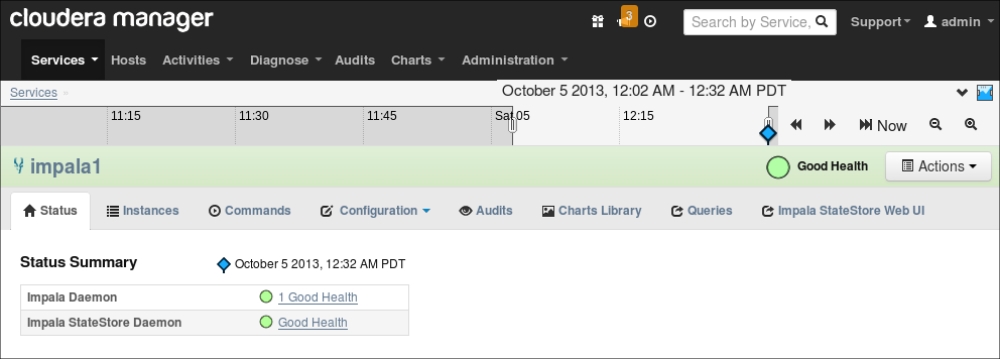Once impala is installed, configured, and ready to start, the next step is to know how to interact with Impala in different ways for various reasons. This chapter explains the various command options to interact with Impala, mainly using command-line references. In the previous chapter, we also discussed various ways to install Impala.
In the previous chapter, we understood that impalad is the Impala daemon, which runs on every node in the cluster and receives queries submitted through various interfaces such as third-party applications using the ODBC or JDBC connectivity, Web interface, or API, and finally the Impala shell. In general, the impala-shell is a process that runs in a node and works as a gateway to connect to impalad through commands. The Impala shell is used to submit various commands that can set up databases and tables, insert data into tables, and finally submit queries on stored data.
Before we jump into Impala shell, let's first try using Cloudera Manager to check the status of Impala. By default, Cloudera Manager configures to run on port 7180. In your cluster where you have installed Impala using Cloudera Manager, open Cloudera Manager in your favorite web browser and browse through all services to check the status of Impala.
If Impala daemon (impalad) and Impala statestore (statestored) are installed correctly and running, you will see them listed as shown in the following screenshot:

As shown in the previous screenshot, both Impala Daemon and Impala StateStore Daemon are running successfully. However, in a situation where Impala shows the Stopped status, you can start both the daemons at once just by using the Actions button on Cloudera Manager, as shown in the following screenshot:

If we list running processes specific to Impala using the Linux ps command, we can find both the impalad and statestored processes listed as follows:
Impala Daemon (impalad)
impala/usr/lib/impala/sbin-retail/impalad --flagfile=/var/run/cloudera-scm-agent/process/21-impala-IMPALAD/impala-conf/impalad_flags
Impala Statestore Daemon (statstored)
/usr/lib/impala/sbin-retail/statestored --flagfile=/var/run/cloudera-scm-agent/process/20-impala-STATESTORE/impala-conf/state_store_flags
We can see that each daemon starts with its flag file, and on opening the flagfile we can learn more about the base settings for both impalad and statestored.
